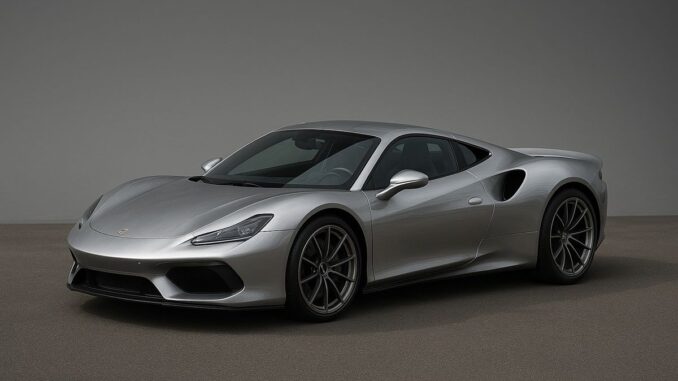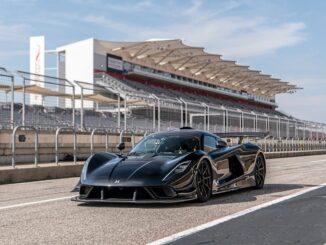
The petrol heads amongst us will no doubt at some time or another, imagined what our perfect dream car would look like. Some of us with an artistic flair may have even drawn something that resembles our dream car.
Well, with this in mind, Romans International, one of the UK’s leading independent luxury and performance car dealership, recently set out to settle an argument that divides Reddit threads and petrol heads alike in determining what does the “perfect” supercar actually look like?
In order to create the “perfect” car, Romans compared 40 of the world’s favourite supercars, taking into account the engine, drivetrain, dimensions, body, doors and materials the car is made of. They then used AI to generate a single, balanced blueprint that they have called the “PJ468”. The end result you can see here, is something rather extraordinary and aesthetically stunning in my opinion.
So, how did they go about build this stunning AI generated silver car?
Well, firstly, Romans recorded the engine capacity and configuration, drivetrain, body and door style, the body material, the car’s dimensions, including the length, width, height and wheelbase. Then the headline performance, including the top speed and 0-60mph sprint.
Secondly, they used means for continuous variables and modal choices for categorical ones to create a data-true composite from 40 iconic car models from marques that included Aston Martin, Bugatti, Ferrari, Porsche, McLaren, Lamborghini, Maserati and Mercedes-AMG. An AI model then generated a coherent design brief and the visual you can see here.
A 4.6-litre V8 engine has been chosen, sitting between the Porsche 918 and Ferrari 458 for capacity, delivering instant throttle response with that classic V8 sound. It’s the connoisseur’s choice, blending a mix of today’s technology with yesterday’s spirit.
Looking at the car’s powertrain and layout, a mid-engine, rear-wheel drive has been chosen, the same setup as in the Ferrari 458 and McLaren 720S, chosen for its ideal weight balance to give razor-sharp handling, making it a true driver’s car.
Rear-wheel drive makes it a car for purists and enthusiasts, reflecting 80 per cent of the models such as the Ferrari 488 and F8, to name just a couple.
When it comes to the AI car’s performance we’re talking about a top speed of 204mph, just below the 205mph of the McLaren 765LT and Ferrari 296. The 0-60mph time of 3.2 seconds matches the sprint time of the Porsche 718 and Aston Martin DBS, making it supercar-quick but not delivered in a brute force way.
It naturally follows that the car is a two-door coupé with conventional doors like most Ferraris and Aston Martins.

An aluminium construction wins with 55 per cent preference in the dataset, just like the Ferrari F12, 812, offering a weight saving and durability over carbon fibre.
The car’s proportions come out at a 4,594mm length × 1,981mm width × 1,237mm height and wheelbase of 2,678mm. This gives the car sleek dimensions in classic McLaren fashion, with a low and wide stature, designed for presence on the road and razor sharp precision on the track.
Lastly, why have Romans’s chosen “PJ468” for the car’s name?
Well, if you look at the names of some iconic classic cars you will see that the names of people have been used by some brands, such as the McLaren Senna, Aston Martin DBS, named after David Brown, who purchased Aston Martin in 1947 and the Bugatti Chiron, named after Louis Chiron, the Monégasque racing driver and Monaco’s first Formula 1 driver.
Ferrari like to use places, take the Ferrari Portofino and Ferrari Roma for example. Lamborghini on the other hand, has named some of their cars after animals with the Lamborghini Aventador and Revuelto.
Both Porsche and Ferrari have named their cars with numbers which often signifies the size of the engine. Take, for example the Ferrari 458/488/812 and Porsche 918.
And so, Romans decided to follow the classic naming conventions seen across the industry. In this instance, the PJ is a nod to Paul Jaconelli, reflecting Romans’ heritage, while 468 reflects the engine capacity and cylinder count, echoing numeric traditions as seen with Ferrari and McLaren.
Paul Jaconelli, Founder of Romans International commented:
“We see hundreds of the world’s most impressive cars, and patterns emerge. The AI didn’t chase extremes. It chose balance; the bits supercar makers most often get right.”
“This isn’t a greatest-hits collage. “It’s the statistical sweet spot turned into a driveable brief.”
For more information on Romans International and its selection of some of the world’s most desirable cars, please visit: www.romansinternational.com.
Author Bio:
Simon Burrell is a UK-based motoring and travel journalist and editor, a member of the Guild of Motoring Writers and former saloon car racing driver.
Images courtesy of Romans International




Be the first to comment